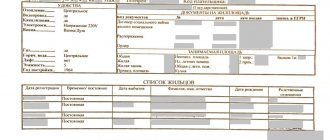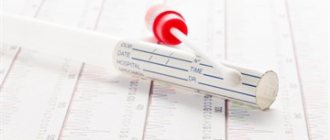The method of genetic analysis of the DNA molecule makes it possible to successfully solve many issues related to determining family ties between people. To date, thousands of people have been able to appreciate the benefits and accessibility of deoxyribonucleic acid examination, which contains genetic information about a specific person, his parents and ancestors.
Most often, this research method is used when it is necessary to do a DNA paternity test. Its results allow you to accurately determine whether a man is the father of a child or not. There are often cases when a woman, even before giving birth, wants to prove that the man was responsible for conceiving the baby. Is it possible to arrange paternity determination during pregnancy? We will talk about this in this article.
Possible results and their accuracy
DNA tests are carried out in special laboratories. Based on the results of the study, one of the following decisions is made:
- Paternity is confirmed with a 99.9% probability. Although this is not 100%, the DNA test results are sufficient for the court to recognize paternity. 0.1% occurs in situations where 2 different people have the same DNA. This is possible, but in exceptional cases.
- Negative answer. A chromosome mismatch always gives a 100% chance that the test subjects are not related.
If samples are collected incorrectly or are provided with low-quality samples, the laboratory may give an answer that the results are false due to insufficient material for DNA collection. In this case, the test will have to be repeated.
Advantages and disadvantages
A prenatal test provides a unique opportunity to identify possible anomalies in the development of a baby record-breakingly early. In a mother's blood test, fetal DNA is determined from 9-10 weeks. At this time, mandatory screening is not carried out. Therefore, testing makes it possible to obtain information about the baby’s condition even before undergoing screening tests in the first trimester. Some women, who have done the test and are convinced that the child is healthy, refuse screening altogether in consultation with a clear conscience.
A new word in prenatal genetic diagnostics is the ability to determine the sex of a child at such an early stage that no modern ultrasound can do this. In this case, the accuracy of sex determination will be 99%, and no one will give more than 80% accuracy with an ultrasound.
Determination by DNA
This is the most reliable and “youngest” method, the results of which are accepted as irrefutable evidence of paternity. This is what parents most often resort to when accuracy in results is required.
It is a comparison of the DNA chains of the child and father obtained from blood, saliva, nails, hair follicles and other biological tissues.
It is enough to provide a small amount of material, for example, take blood from a finger or a scraping from the roof of your mouth. Information from both parents and the baby will be required.
Having deciphered the DNA code, specialists can:
- confirm that the man is 99% the father of the child.
- disprove the probability of paternity 100%.
It's worth noting that a DNA test usually takes about two weeks, but in emergency cases can be completed in three days.
Basically, a sample of organic tissue is obtained from an already born child, but not so long ago a non-invasive or prenatal method was invented that allows you to “work” with pregnant women in the early stages.
It can be used starting from the tenth week. The work uses the father's blood and the mother's venous blood, which contains a small amount of the child's DNA. This option is highly accurate and can be used instead of traditional analysis.
Establishing paternity is necessary in many cases: to recognize a man as a parent, to force child support payments, etc. To obtain the most accurate result, it is necessary to do a DNA analysis: it is carried out in specialized clinics in Moscow or other cities. Its price starts from ten thousand rubles.
Watch the video in which a specialist explains in detail how a DNA paternity test occurs:
DNA test to determine the father of a child during pregnancy
Thus, by DNA testing using a woman’s venous blood, it is possible to find out who the father of the child is during pregnancy, without exposing the mother and fetus to risks . High accuracy and safety are the main advantages of such research.
Testing is carried out as follows:
- samples of biomaterial are taken;
- DNA sections of the fetus are isolated from the mother's material;
- in laboratory conditions, alleles in the loci of the fetus and the man are compared;
- An expert opinion is drawn up.
Testing is carried out starting from the seventh week of pregnancy . During this period, the child’s DNA can be extracted from it. The analysis will require 20.0 ml of the woman’s blood. Samples of buccal epithelium or any other biological material are taken from the putative father - skin particles, hair, nails, toothbrush, earwax, battle, etc.
The laboratory is conducting research on SNP markers. If the fetus is male, then the Y chromosome, which is passed on to the child from the father, is analyzed. If the fetus is female, then both chromosomes are analyzed to determine identity with the father's markers.
The test results are recorded on a special form, indicating the date, signature of the laboratory director and stamps. The study allows us to establish the fact of biological relationship with a probability of 99.999% . In case of a negative result, the probability is 100.0%.
The non-invasive research technique is not used if the woman or man had a blood transfusion or a bone marrow transplant six months before the test.
Myth 10. The child’s father is no longer alive, now I will never prove that this is his child
This is wrong. You can do an analysis with the father's relatives, confirming or excluding paternity - analysis of grandparents, grandchildren, brother-sister, uncle-aunt-nephews. If grandparents are involved, then this analysis is not inferior in accuracy to paternity. Brother-sister and uncle/aunt-nephew analysis is also quite accurate, but the participation of the mother is desirable. If you need such an analysis, then you need to choose a laboratory that makes the maximum number of DNA sections (loci) so that the accuracy is as high as possible. Also, in some cases of relationship, use Y-chromosome analysis and X-chromosome analysis, they give very high accuracy.
When can you do a DNA test?
Medicine does not stand still. Today, a DNA test can be performed not only after the birth of a child, but also during a woman’s pregnancy. The latter option should be resorted to only in extreme cases, since an examination of an unborn fetus can provoke premature birth or even cause the need for an urgent abortion.
Unborn baby DNA test
A DNA test during pregnancy is usually carried out to identify genetic abnormalities and defects, if the doctor suspects this. Establishing paternity before birth is dangerous - it can cause death or deterioration in the health of the unborn child.
A DNA test can be performed on the fetus only if the woman consents to this procedure. During sampling, a needle is inserted into the umbilical cord, amniotic sac or embryo. There are several ways to collect data for analysis:
| Way | When is it held? | How is the material collected? | Possible risks |
| Chorionic villus biopsy | Until the 12th week of pregnancy | A needle is inserted into the woman through the vagina or anterior wall of the abdomen to the membrane of the fetus. | Termination of pregnancy (3%). |
| Amniocentesis | At 14 – 20 weeks of pregnancy | A long needle is inserted through the abdominal cavity | Possible complications (1%) |
| Cordocentesis | After 20 weeks of pregnancy | Blood is taken from the baby's umbilical cord | Chance of complications 1% |
The level of risk of fetal disease depends on a combination of factors: the professionalism of the doctor performing the procedure, the quality of the instruments used and the health of the pregnant woman. The study itself is a complex one, and not every clinic undertakes it.
Genetic test for a newborn child
It is best to collect material from an already born child. In this case, there is no risk of complications. Today there are several methods for collecting DNA:
- Taking blood. Nowadays it is used extremely rarely, as other methods have appeared that allow you to quickly and painlessly collect material.
- A swab from the inside of the cheek. This is the most common option. Saliva contains DNA, just like blood. The reliability of the results obtained in both cases is the same.
Taking a smear is also popular because a person can collect DNA material on their own and submit it to a clinic for analysis. To do this, just use a clean cotton swab to remove saliva from yourself and your child from the cheek in your mouth, place it in a special container and transfer it to the laboratory.
To ensure that the materials are suitable for the study, both test participants must not eat, drink or smoke for 2 hours before collecting saliva.
There are also less standard options for collecting DNA samples. They are not used in all diagnostic centers. Such clinics accept as material:
- hair;
- teeth;
- sperm;
- nails;
- saliva (not collected from the cheek);
- tissue obtained after biopsy.
But there are additional requirements for their fence. For example, hair must have follicles, since they contain DNA. If a woman wants to do the test in secret from the alleged father, she can provide the center with the man's personal belongings, such as a toothbrush, cigarette butt or napkin. However, the possibility that they were used by someone else must be excluded.
Non-invasive prenatal test - effectiveness and risks
A non-invasive method for diagnosing the contents of the test is considered gentle and practically does not entail significant complications, since there is no invasion of the amniotic fluid or the woman’s uterus; specialists only take the venous blood of the expectant parents for analysis. Usually its volume does not exceed 18 milliliters. It is placed in a specialized apparatus and is cooled to the required optimal temperature.
After which, the specialist separates the mother’s DNA from the child’s DNA, and then calculates the data using a computer program, which gives the final result as a percentage.
The effectiveness of this method is determined by the safety for the health of the patient and fetus and the accuracy of the analyzed data. The risks of pathological processes and miscarriage are minimized. The only difficulty for mom and dad may be financial support for the procedure.
Testing to establish paternity is important both after childbirth and during pregnancy. It has certain risks for the child and the woman in labor, especially if the procedure is carried out using invasive methods (sampling of material through penetration through the abdominal cavity or uterus). These methods are agreed with the doctor and are carried out only in the absence of pathologies and problems with the woman’s health.
Who is the initiator?
This question is very important.
To conduct a woman-initiated prenatal invasive test, it is important to contact a gynecologist. A woman's doubts about who the true father is, of course, are not grounds for a traumatic invasion of the uterus
Therefore, the expectant mother will first be told about what horrifying consequences can be for the child - death, termination of pregnancy, intrauterine infection, injury to the baby with long sharp needles, which are used to puncture the uterine wall to obtain biomaterial. If the lady continues to insist after this, she will undergo invasive diagnostics.
A non-invasive DNA test simply involves drawing blood from a vein and is carried out with the written consent of the pregnant woman for such an examination (in fact, a regular blood test). The examination is paid, is not carried out under the compulsory medical insurance policy, and is not done in every clinic, but in specialized medical and genetic centers.
If the future dad insists on a paternity test (which happens somewhat more often), then his options are generally limited. In any case, he needs to obtain consent to examine the woman. Without it, the man will be categorically denied the test. You will have to wait until the baby is born to insist on a genetic analysis to determine the relationship (by a court decision or by voluntary consent of the parties).
Legal advice
DNA testing to determine paternity during pregnancy is an expensive, complex and unsafe procedure for a woman’s health.
However, a paternity test during pregnancy using DNA analysis can determine blood relationships with an accuracy of 99.99%. Such high reliability of the result encourages men and women to resort to the services of specialized medical institutions without waiting for the birth of the child.
Expert opinion
Dmitry Nosikov
Lawyer. Specialization: family and housing law.
It is important to remember that the law protects the rights of a pregnant woman and allows her to refuse to undergo a procedure that threatens her with a number of risks, complications, dangerous consequences, including the loss of the child.
In addition, a claim to challenge paternity can be accepted and considered by the court only after the birth of the child.
If you have a dispute, disagreement, if you need legal support in the process of preparing for a medical procedure or a trial to challenge paternity, you can always count on the competent assistance of our lawyer.
To get a free consultation, write to the 24-hour support chat or call the hotline. Attention!
- Due to frequent changes in legislation, information sometimes becomes outdated faster than we can update it on the website.
- All cases are very individual and depend on many factors. Basic information does not guarantee a solution to your specific problems.
That's why FREE expert consultants work for you around the clock!
- via the form (below), or via online chat
- Call the hotline:
- Moscow and the Region
- St. Petersburg and region
- FREE for a lawyer!
By submitting data you agree to the Consent to PD Processing, PD Processing Policy and User Agreement.
Anonymously
Information about you will not be disclosed
Fast
Fill out the form and a lawyer will contact you within 5 minutes
Tell your friends
Rate ( 2 ratings, average: 5.00 out of 5)
Author of the article
Irina Garmash
Family law consultant.
Author's rating
Articles written
612
How is an invasive paternity test performed during pregnancy?
An invasive method of DNA testing involves the removal of tissue samples, biological fluids, and blood by penetrating the natural external barriers of the mother and fetus. The procedure is carried out only in a specialized medical facility.
To conduct a DNA test using an invasive method, in addition to the perinatal biological material of the child, DNA samples from the mother and the putative father are required. For this the following can be used:
- cheek scrapings,
- biomaterial from a toothbrush,
- hair with hair follicles,
- dry blood,
- saliva,
- sperm, etc., from which DNA can be extracted.
In parallel with paternity tests, a test for genetic diseases (for example, Down syndrome) can be carried out or, conversely, under the pretext of checking hereditary diseases, it is also possible to establish paternity. The research can be conducted anonymously.
The child's parents should be warned about the possible risks associated with the methods of collecting perinatal material during the invasive method.
In order to obtain biological material from the unborn baby, a pregnant woman has to undergo any of the following procedures:
- Amniocentesis is a puncture (puncture) of the amniotic membrane of the fetus in order to obtain amniotic fluid. This manipulation is carried out at 14-20 weeks of pregnancy by puncturing the skin and anterior abdominal wall of the mother with a thin long needle, penetrating the uterus, puncturing the amniotic sac and collecting a small volume of amniotic fluid (amniotic fluid) from the cavity of the amniotic sac. The risk of miscarriage or complications after the procedure is 1-2%.
- The CVS method (chorionic villus biopsy - the membrane of the fetus) is carried out at earlier stages, starting from the 9th to 12th weeks of pregnancy (acceptable from 8 to 14 weeks), that is, during the first trimester, which is the advantage of this method. BVS is performed using a biopsy syringe or a thin aspiration catheter, which is used to puncture the abdominal wall and uterus (or access is through the vagina and cervix, depending on the location of the fetus) to remove amniotic fluid along with the villi of the outer membrane of the embryo (10 are enough for analysis). -15 mg). The procedure is performed using an ultrasound machine to prevent damage to the fetus, so the risk of potential complications after the intervention is 2-3%. Next, the sample is thoroughly cleaned from the mother’s tissues and blood, and then placed in a special medium and submitted for analysis. Chorionic villi have the same genetic structure as fetal tissue.
- Cordocentesis is carried out after the 18th week of pregnancy, and with this method a sample of fetal blood is obtained from the vessels of the umbilical cord by puncturing the anterior abdominal wall and the mother's uterus with a long needle. A puncture point is selected at a distance of 3-5 cm from the place of attachment of the umbilical cord to the placenta - the required amount of blood is drawn from the lumen of the umbilical cord vessel. The procedure is carried out under ultrasound control. The risk of complications or premature birth after this procedure is reduced to 1-2%.
- More accurate DNA test results are obtained if it is performed after the 24th week of pregnancy. Starting from this period, amniotic fluid is subject to examination, a sample of which is taken by inserting a needle into the uterus through the abdominal wall. The procedure is performed using an ultrasound machine so that the position of the needle can be monitored, and the risk of complications from this procedure is reduced to 1%.
After collecting the necessary biological material for research and extracting the child’s DNA from it using microarrays with a large number of genetic markers (hundreds of thousands of options) and special computer programs, the samples are compared and the data is processed. The test takes 5-7 days to complete.
Carrying out a DNA test during pregnancy is not an easy task, much more difficult than conducting a similar test on an already born child. And only a very experienced specialist can cope with the procedure for collecting fetal biomaterial (otherwise there is a risk of losing the child).
However, there is no reason not to trust the reliability and correctness of the medical report (the accuracy of the examination is 99-100%) of the test, since neither the mother’s illnesses nor any other processes occurring in her body at this time affect its result . However, if there is a risk of complications or a threat of miscarriage, the procedure to establish paternity is postponed until the baby is born.
DNA testing results can be notarized and used as official proof of paternity in legal proceedings.
Test for legal paternity establishment
By conducting a blood test, you can confidently exclude the possibility of paternity if the child’s blood type and Rh factor do not correspond to possible combinations of parental indicators. Thus, such tests can only establish whether the relationship of specific citizens can be asserted or excluded. The methods described above are not suitable for accurately confirming a child’s heredity, but analysis of parental DNA will provide an accurate confirmation of relationship with a probability of 99.99%.
Unfortunately, the instability of couples living in a civil or official marriage increasingly leads to the need to check the presence of family ties. Often, a DNA test is used in court to officially recognize a specific person as the father and to collect child support from him.
Typically, a DNA test performed non-invasively is completely painless and requires no prior preparation. It’s another matter if DNA analysis is required during pregnancy and involves the use of an invasive method. In this case, there is a certain risk to the fetus, and it can only be performed during a certain period of pregnancy.
Within 5-7 days, if the test is urgently performed, the parents receive a medical report, which can then be used by official authorities (when determining the payer of alimony, establishing the status of the father), or to resolve intra-family conflicts, proving the relationship of the spouses with the newborn.
Everyone is free to choose their own research methods, because it is better to know the true state of things than to live life in doubt and mistrust.
Need some advice? directly on the site. All consultations are free / The quality and completeness of the lawyer’s response depends on how completely and clearly you describe your problem:
Article published: 2018-03-19
Rating: 5 out of 5
Questions of biological kinship are relevant at all times, and most often there is a need to accurately determine the father of the child. Modern technologies make it possible to find out who the father of a child is during pregnancy by conducting a DNA test.
This method is the only one that allows you to determine paternity before the baby is born . At the same time, its accuracy and reliability does not raise any doubts and is confirmed by successful world practice.
Methods and timing of the examination
There are two most common ways of conducting prenatal genetic testing: invasive and non-invasive. Both of these methods make it possible to guarantee an objective result of a paternity test, since they are based on DNA analysis - a universal carrier of unique information about each person. But at the same time, there are certain differences. For a complete understanding, we will consider each of the methods separately.
Invasive method
The invasive method is a traditional and longer practiced method of determining paternity, based on comparison of biological material from the father and the unborn child.
In fact, what is called invasive is not the analysis method, but the method of collecting biological material - it requires direct intervention in the body of a pregnant woman. So, in order to obtain genetic samples of the fetus, the woman being studied will have to undergo:
- amniocentesis - puncture of the amniotic sac and uterus to obtain amniotic fluid;
- Chorionic villus biopsy - a puncture of the abdominal wall and uterus to obtain amniotic fluid.
After collecting the required amount of material, the samples are compared using software.
Non-invasive method
Since the invasive method is considered quite dangerous, to ensure the safety of the mother and the unborn baby, a non-invasive method of collecting biological material was developed that does not require intervention in the woman’s body.
Non-invasive prenatal DNA paternity testing is performed on the basis of venous blood taken. Blood sampling can be carried out in any medical institution using a regular syringe, which is why this procedure is considered safer and cheaper. Because of this, it is practiced much more often. The objectivity of the non-invasive method is also beyond doubt.
Timing of the examination
Regardless of the method used, examination of the obtained biological samples and interpretation of the results usually takes no more than 5-7 days. The deadline is 14 days, and only if the study is carried out in a provincial center. Much more interesting is the answer to the question of how long it takes to determine paternity. Here the method used already matters.
Thus, in the case of invasive sampling, the minimum gestational age should be 8-14 weeks for biopsy and 14-20 weeks for amniocentesis. As for non-invasive sampling, it is possible no earlier than 10-16 weeks of pregnancy.
Myth 4. I can’t do the test secretly from the child’s mother.
You can. The mother is not needed for paternity testing. It can be used for higher accuracy, but the accuracy of the analysis is usually already quite high. 99.999% or 99.999999% is not important for confirming paternity, and if paternity is excluded, 0% will be with or without the mother.
The only time the test should be done with the mother is if there is any doubt about maternity, the mother's participation in the paternity test will cost much less than a separate maternity test.
Sometimes the mother asks whether the father has the right to do a DNA test without her knowledge. If the father is the official parent, then he can do a DNA test, even for use in court, without the consent of the mother. If he is not officially the father, then he can also do a DNA test; there is no law that prohibits this. True, in court they may find fault with such an analysis due to the fact that it was not his legal representative who signed for the child.
Judicial order
If a man refuses to recognize himself as a father voluntarily and does not submit an application to the registry office, then paternity can be confirmed in court, in accordance with Article 49 of the Family Code of the Russian Federation.
A similar procedure is applicable for any controversial, complex or contradictory cases. The practice of our work shows that judicial establishment of paternity takes much more time and effort.
As with voluntary procedures, the procedure for collecting and submitting documents plays a key role. Of course, much more documents are needed for the court, and their content must be comprehensive and confirm the position of the plaintiff. Here is a general list of documents that must be submitted to the court office:
- A statement of claim drawn up in accordance with the Code of Civil Procedure. In writing, indicating information about the plaintiff and defendant, the essence of the dispute and additional circumstances of the case. A copy of the claim must be sent to the defendant as soon as the documents are accepted by the court for processing.
- Receipt for payment of state duty.
- Notarized power of attorney, if the application is submitted by a representative of the plaintiff.
- A copy of the passport or other identification document of the plaintiff.
- Written testimony that can confirm a man’s participation in the life and upbringing of a child.
- Photographs, letters, notes, audio and video recordings confirming the fact of the relationship between the plaintiff and the defendant.
- The results of a genetic examination confirming blood relationship (can be ordered by the court during the process, but to save time it is better to do it yourself. All expenses will be compensated by the defendant as soon as the claim is satisfied).
- Child's birth certificate.
The list can be supplemented as During judicial proceedings, each party has the right to make additional requests, provide evidence, and bring witnesses. The plaintiff may attach any documents confirming his position.
FAQ
Is it possible to do a DNA test remotely?
This cannot be done using an invasive method. Only a doctor can take amniotic material, and only under sanitary conditions.
For a non-invasive study, anyone can take blood if you buy a certain kit, with which you can painlessly take blood yourself at home, and send the material for analysis by courier. Such kits are often offered by paid clinics and chemical laboratories.
If you are absolutely sure that you can handle it, do it. If not, you need to go to the hospital.
If a woman is carrying twins
As a rule, when there are several fetuses in the womb, it is considered inappropriate to do a DNA test before the babies are born. Why?
- There is a fairly large danger of erroneous interpretation of the results.
- It may turn out that conception occurred from different men.
Is it necessary for every potential father to donate blood if they are related?
Each possible parent will have to give their biological material. It is recommended that these tests be carried out simultaneously and blood taken from each man. Because it is possible, by testing them separately, to obtain a conclusion that both of them are the fathers of the child, which means that the woman became pregnant from both one and the other.
Establishing paternity is a serious matter and very important in the life of any person. Modern technologies allow it to be carried out extremely carefully so as not to harm the baby.
Some may be worried about whether a DNA test could be wrong. It must be agreed that the recognition of research methods based on blood type, eye or hair color as ineffective is quite justified, since they do not give a 100% result. DNA research is a method that is considered the most accurate for establishing kinship and will reliably establish paternity.
You can choose to test any of the described methods, but think first of all about the safety of the unborn baby and the health of its mother.
Analysis results
The result of the DNA analysis is prepared within 3 to 14 days. The accuracy of the study is 99.9%.
Possible difficulties during analysis:
- If the potential fathers are relatives. Testing must be carried out at one time. Otherwise, the result may be positive in both cases.
- If a woman is pregnant with twins. Analysis is prohibited. Since the fathers of the children can be different men, the exact result is not guaranteed.
Method of collecting genetic material from a child
New opportunities in the field of diagnostics have made it possible to determine paternity in the womb in the early stages. When choosing how the genetic material will be taken, you should proceed from what the gynecologist recommends and what the period of pregnancy is at that moment. There are two collection methods:
- Invasive - allowed to be carried out exclusively in a medical institution. And all because there is a possible danger to the health of mother and baby. It is not at all necessary to go to a hospital or private clinics. There are laboratories that do not accept patients, but only do chemical tests, including DNA tests.
When using these methods, the material will be:
- chorionic hairs;
- amniotic fluid;
- baby's cord blood.
- Non-invasive antenatal DNA testing
Now this method is not widespread, however, it has a leading advantage over other tests, since complications after its implementation are not observed in either the mother or the child. The best time to conduct the study begins at 4 months of pregnancy (if a Y chromosome is detected). The closer the birth is, the greater the chances of finding an independent DNA chromosome of the embryo in the mother’s blood plasma.
| Gestational age at the time of analysis | Tendency to terminate pregnancy, % | |
| Invasive | ||
| biopsy of germinal hairs | 9–12th | 2 |
| amniocentesis | 14th–20th | 2 |
| cordocentesis | 18–24th | 1 |
| Non-invasive | from 9th |
Now let's talk about the cost of these tests. Let's look at the example of Moscow, how much it costs to order a paternity test. The difference in the cost of individual methods is significant. The non-invasive method is almost three times more expensive than the invasive method (60–90 and 20–30 thousand rubles, respectively). This is explained, first of all, by the fact that it is a safe and high-tech method.
How much does genetic testing cost?
If 5-10 years ago DNA analysis was a rare and expensive test, now it is available to the majority of the population. On average, this procedure will cost 10-30 thousand rubles. The most budget-friendly option is to carry out a genetic examination in a standard mode: submit the biomaterial directly to a DNA laboratory and get the result within 20-30 days. You will have to pay a larger amount if you do an express analysis and issue a conclusion in 1-3 days.
Latest articles:
- What is a genetic passport?
- Is DNA testing really reliable?
- How to find out the gender of the unborn child without an early ultrasound?
- NIPT for a happy pregnancy
- DNA test for ethnic origin - frankly and to the point
Article prepared by:
Petrov Dmitry Member of the Integrated Scientific Group Lab-DNA
How soon can you test your baby's DNA after birth?
You can check your baby's DNA after birth, as soon as the hospital staff has completed all the procedures required for a newborn.
Because an inner cheek swab is used to collect DNA samples, it is important that the baby's mouth is free of meconium, amniotic fluid, or breast milk when collecting DNA.
5 Tips for Collecting DNA from a Newborn Baby or Infant
- Do not feed or give your child water for 60 minutes before the smear test. Failure to follow this recommendation may not change the DNA or affect the test results, but it may contaminate the sample and require the collection of new DNA samples.
- Perform a swab of the child's mouth while he sleeps. It is difficult to perform this procedure with a constantly moving baby, so doing it while he is sleeping is a great solution to the problem.
- Be sure to swab each swab for 30 seconds on the inside of your cheeks, while trying to avoid touching the swab to the gum area
- If the swab appears slightly damp after the swab, simply hold the swab in the air for about 60 seconds before placing it in the paper sample envelope.
- Do not touch the tip of the swab with your hand to prevent introducing foreign DNA into the sample.
DNA testing process to establish paternity
What do you need to do a DNA paternity test?
All that is needed to perform a DNA paternity test are DNA samples from the alleged father, the child in question, and the child's mother (her participation is optional but recommended).
How to perform a DNA paternity test?
There are two parts to all paternity tests: collecting DNA from test participants and then testing and analyzing the samples in a laboratory.
How DNA is collected
- DNA for paternity tests is extracted from the epidermal cells of the participants' inner cheeks, which are collected using a simple, painless swab
- Each participant is provided with four tampons; Using one at a time, the tip of the swab is pressed firmly against the inside of the cheek to collect DNA. An adult test taker can swab a child or infant
- The swabs are then placed in paper envelopes; paper containers allow the organic material on the swabs to “breathe” and prevent mold contamination when they are sent to the laboratory. If the swabs seem too wet, wave them in the air for a few minutes to dry them out a bit before putting them in the paper envelopes.
- In some rare cases of the postpartum period, a blood sample can still be used to obtain a DNA sample, but today cheek swabs are the norm. DNA collected with a swab from the inside of the cheek is as reliable for testing as DNA extracted from blood
How is performed in the laboratory
- DNA is extracted from each participant's cells and then amplified (multiplying the number of DNA molecules) to make the sample more workable
- At least 16 STR STR markers are analyzed for each participant (DDC baseline is 20 markers) using Short Tandem Repeat (STR) Analysis to collect genetic information for each marker
- The geneticist uses this data when performing a calculation of the probability that the person being tested is the biological father of the child being tested
Can a DNA paternity test be done at home?
Collecting DNA samples to establish paternity can be done at home if you want the results for your information and peace of mind only If you need results for any legal reasons, such as financial support or criminal investigations, then you should order a legal, certified paternity test instead of a home test.
For home test:
- You can order a DNA sample collection kit online or even pick it up at your local pharmacy
- When you receive a kit from a store, you pay the retailer for the kit and then make a separate payment to the lab to complete the test once you are ready to test
- Collect DNA samples at home, register the kit with DDC online, and then send sample swabs directly to the laboratory
- When the test is completed, a results report is sent to a secure online account or can be mailed to you. For security reasons, reports are never delivered by email
Pro Tip: Your DNA test kit from DDC comes with a USPS mailer. Samples sent in this mailer may take up to 10 business days to reach our laboratory. If you need results faster, pay a little more to ship samples via FedEx or UPS.
Where can you order a legal DNA paternity test?
In order for paternity test results to be admissible in court, the collection of samples and their delivery to the laboratory must be supervised by an approved, disinterested third party. Here's how it works:
- Call the laboratory directly to request a legal test
- The laboratory will schedule an appointment (or appointments) for participants at an approved DNA collection facility near you
- The DNA testing kit is then sent directly to the collection site
- Participants arrive at the appointed time (they do not have to all be present for the same procedure for other participants)
- A designated collector checks identification documents, receives, photographs participants, and supervises (or performs) the collection of DNA samples
- The DNA collector fills out the necessary documents and forms that are included with the samples when they are sent to the laboratory
When the test is ready, a results report is sent to a secure online account or can be delivered by mail. For security reasons, reports are never delivered by email.
Because the chain of custody and collection of samples is controlled by a disinterested third party throughout the DNA collection process, and the identities of test participants are documented, only legal tests like the one described above can provide court-admissible results.
How long does it take to get results?
Once samples arrive at the laboratory, DDC's standard turnaround time for paternity testing is two (2) business days, although 1-day results and same-day results are available at an additional cost.
How accurate are the results?
At DDC, each test is run by two separate teams to ensure accuracy, so you can be confident that the results will be accurate for the samples you submit for testing. As mentioned, the results of legal, certified paternity tests from an accredited laboratory are accepted as proof of paternity by the courts and may also be used for immigration purposes.
IMPORTANT FACT: The only difference in the testing process between a home paternity test and a legal paternity test is how the DNA samples are collected. Once the samples reach the laboratory, the testing process is identical in both cases.
How to Interpret Paternity Test Results
Accreditation bodies require laboratories to use specific legal language when reporting a DNA paternity test. Here's what it means, put into simpler language:
is determined to be based on testing results , the report contains the following :
- A statement stating that the alleged father is not excluded as the biological father of the child being tested. This means that based on statistical calculations he cannot be excluded as the putative father and is considered the biological father of the child
- The Composite Paternity Index ( CPI ) is a calculated metric that determines the chances that a man being tested is the father of a child. For example, a CPI of 43,110,000 means that there is a 43,110,000 to 1 chance that someone other than the subject was the biological father.
- Probability of paternity , which is given as a percentage, is an indicator that this person is the father. This typically has a value of 99.9% or higher, it should be read as: There is a 99.9% chance that this person is the biological father of this child.
If the man is not recognized as the biological father, the report contains the following :
A report stating that the alleged father is excluded as the presumed biological father of the child being tested. This means that he cannot be considered the biological father.
Composite Paternity Index ( CPI ), which is a measure of the chances that a man is the father of that child. For cases where paternity is excluded, this number is always 0.
Probability of paternity , which is reported as a percentage, is an indicator of the likelihood that this person is the father of the child participating in the test. For cases where paternity is excluded, this number is always 0.
Instructions for collecting material
It is very important to follow the rules for collecting material, which can directly affect the accuracy of the test results. This is especially true for those people who have chosen to collect biological material at home.
- In no case should you touch the fence item with your hands; to do this, you must use gloves and sterile tweezers, which then place the material in a special container;
- if it is a toothbrush, then its service life should not exceed a week;
- if there are stains on clothing, they must be carefully cut out with scissors, and then also placed with tweezers in a sterile envelope or container;
- chewing gum or cigarette butts, pre-dried;
- hair is provided for analysis only with bulbs and preferably about 10 pieces;
- You can collect saliva with a sterile cotton swab.
If you collect biological material at home, it is very important to follow not only the above rules regarding individual items, but also to ensure that no one touches them during their storage (for example, if it is chewing gum or a cigarette butt). Otherwise the results will be distorted
Types of testing
During pregnancy, 2 DNA testing methods can be used:
- Invasive involves the use of special medical devices to penetrate the internal cavity of the uterus of the expectant mother.
- Non-invasive is carried out without such penetration.
Non-invasive test
The essence of testing is to take 20 ml of blood from the expectant mother and 10 ml from the father. But due to the complexity of the procedure, this technique is used quite rarely. The study is not carried out if one of the future parents received a blood transfusion in a period less than six months before testing.
To use test results in court proceedings as an integral part of the evidence base, the services of a notary will be required. He must certify this document, otherwise the conclusion will not have legal force.
Invasive testing
Parents can provide DNA testing materials in the following ways:
- cheek scraping;
- saliva samples;
- dry blood;
- hair with bulb;
- sperm;
- biomaterial can be taken from a toothbrush and so on.
As for fetal biological samples, the method of obtaining them will depend on the stage of pregnancy:
- From the 9th to the 12th week, doctors conduct a biopsy examination of the chorionic villi. The entire process is monitored using an ultrasound machine. During the indicated period, the fetus is surrounded by the chorion. Its structure is similar to the genetic material of the unborn child, so villi or outgrowths of the chorion are used to carry out the test. To obtain material, a puncture through the abdomen or vagina is used. You can also insert a suction catheter into the cervix. The choice of a specific method depends on the position of the child and is carried out by the doctor.
- Between the 14th and 20th weeks, a procedure called amniocentesis is performed. Its essence is to take a small amount of amniotic fluid using a syringe, which is inserted into the stomach of a pregnant woman. The entire process is controlled by an ultrasound machine.
- During the 18th to 21st weeks of pregnancy, paternity is determined by blood from the umbilical cord (cordocentesis). This procedure is very difficult, since the fetus has great mobility. And a specialist needs to pierce the amniotic sac and take blood from the umbilical cord, so doctors in certain situations immobilize the baby with the help of medications.
Contraindications
Yes, it is worth recognizing that a paternity test during pregnancy is a rather dangerous procedure with a large number of contraindications, so first of all, the expectant mother should consult her doctor.
In the following cases, conducting this research is strictly prohibited:
- Increased body temperature.
- During exacerbation of chronic illnesses.
- Uterine bleeding.
- Large uterine fibroids.
- Problems with uterine tone.
- Infectious diseases of the skin of the mother's abdomen.
- Isthmic-cervical insufficiency.
- Adhesions of organs in the pelvic area.
- Unavailability of material for biopsy.
If at least one contraindication is detected, the doctor may recommend waiting until the child is born, and only then conducting this study.
In addition, the expectant mother must be informed about the possible risks:
- In case of access through the anterior abdominal wall of the mother, the probability of miscarriage can be 0.88-2%.
- After sampling, a retroplacental hematoma is formed in 0.4% of cases. It has virtually no effect on pregnancy and the condition of the fetus.
- In case of access through the cervix of a pregnant woman, the probability of termination of pregnancy is 2-14.3%.
- After an invasive procedure, chorioamnionitis (infectious inflammation) is observed in 3% of cases. To avoid chorioamnionitis, the mother must take a course of antibiotics, and this is also dangerous for the unborn baby.
- After the test, in 50% of cases, a pregnant woman begins to bleed, which goes away within 1-2 minutes.
- After the procedure, in 12% of cases, a decrease in the fetal heart rate (HR) is observed, which in rare cases can lead to its death. It usually normalizes on its own.
It is also worth noting that as of 2021, the price of a paternity test is quite impressive. Moreover, the procedure itself is painful. After the procedure, the woman may have a stomach ache for some time.
Therefore, if the expectant mother is very suspicious and anxious, then this can provoke not only a depressed mood, but also panic attacks.
Therefore, it is necessary to carry out invasive studies only in case of medical indications, for example, for the early detection of genetic pathology.
Similar articles:
- The procedure for establishing paternity at the registry office
- DNA paternity test
- Responsibilities of parents to children
- What does improper performance of parental responsibilities mean?
- Responsibilities of godparents
- Previous post What signs can be used to determine paternity without DNA?
- Next entry How to formalize a renunciation of paternity?
Comments on the article “Can paternity be established during pregnancy?”
Nobody has written anything yet. Be the first!
What it is?
Previously, geneticists could not establish paternity before the child was born. A little later, methods appeared, but this was associated with an unjustified risk in this case - in order to obtain materials (blood, amniotic fluid, particles of the baby’s epithelium), which can be used to conduct a comparative analysis of the DNA of the potential father and baby, it was necessary to carry out prenatal invasive diagnostics. In other words, we had to puncture the amniotic sac and take materials for analysis. This increases the likelihood of intrauterine infection, miscarriage, and establishing paternity is not a compelling reason for invasive diagnosis.
The current test (NIPT) is not invasive. That is, it is not associated with any risks for the expectant mother and baby, and its accuracy is no less high. Is this research reliable? Undoubtedly. And that's why.
Therefore, the child’s DNA obtained from the research material (about it below) necessarily contains paternal and maternal chromosomes, which make it possible to identify the relationship as accurately as possible.
Basically, you can do tests in two ways:
- apply invasive diagnostics;
- do NIPT (non-invasive test).
In the first case, DNA is isolated from fetal biomaterials: particles of blood, epithelium, water. In the second case, maternal blood from a vein is sufficient - at more than 9 weeks of pregnancy, according to obstetric standards, the baby’s red blood cells partially penetrate into the mother’s blood, which allows them to be isolated and DNA examined.
Non-invasive test
As mentioned above, methods for determining paternity are divided into two types - invasive and non-invasive, what is their fundamental difference from each other?
Invasive prenatal testing:
- fundamentally accurate analysis of genetic material;
- research time does not take much time;
- testing only takes place with the DNA of the child’s alleged father and the genetic material of the fetus;
- The disadvantage of such a test is the need to interfere with the normal course of pregnancy.
At the same time, let’s look at the characteristics of non-invasive analysis:
- when using this method, complete safety for the course of pregnancy is maintained;
- recommendations for conducting such a test indicate the need for research at a later stage, 10–16 weeks of pregnancy;
- The accuracy rates are also very high.
The non-invasive test allows you to determine the origin of the child by collecting and analyzing venous blood from potentially close relatives.
If the study indicates a result that is equal to 99.9%, this means that the putative father has the same genetic markers as the child. From these results we can draw a conclusion about the degree of relationship between the subjects.
A non-invasive method for determining paternity cannot be used if one of the parents has had a bone marrow transplant or has undergone a blood transfusion within the last 6 months.
The non-invasive method is the safest for mother and child.
Is it possible to conduct a DNA test to confirm paternity during pregnancy?
Relationships between men and women regarding marriage, its dissolution, and the birth of children can develop differently.
There are often cases when a potential father of a baby doubts the fact of conceiving a child, giving weighty arguments and justifying his position. Today, the only accurate confirmation of paternity is a DNA test. The fact is that deoxyribonuclinic acid, being in a woman’s cell, contains the genetic information of real parents. The point of such a study is to compare the DNA material of the child in the womb and the data of the father, after which it is possible to conclude that paternity is up to 99%.









